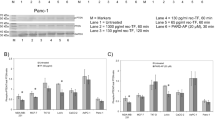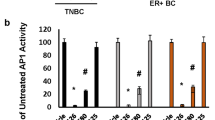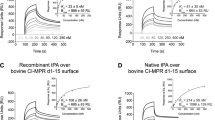Abstract
The urokinase-type plasminogen activator receptor (u-PAR) has been implicated in tumor progression, and previous studies have shown that the expression of this gene is strongly up-regulated by PMA. Although the signaling mechanism by which PMA modulates u-PAR expression is not known, the effect of this phorbol ester on the expression of other genes has been ascribed to activation of the c-Raf-1-ERK signaling pathway. However, in the current study we examined an alternate possibility that the inductive effect of PMA on u-PAR expression also required a JNK1-dependent signaling cascade usually associated with stress-inducing stimuli. PMA treatment of the u-PAR-deficient OVCAR-3 ovarian cancer cells, which contain low JNK activities, resulted in a rapid (5 min) increase in JNK activity. Maximal JNK activity (12-fold induction) occurred after 30 min; this preceding the earliest detected rise in u-PAR protein (2 h). Dose-response studies with PMA also indicated that the increased JNK activity was tightly correlated with elevated u-PAR protein levels. The stimulation of u-PAR promoter activity by PMA required an intact upstream AP-1 motif (−184) and in PMA-treated cells this motif was bound with c-Jun as indicated from mobility shift assays. PMA up-regulated the c-Jun trans acting activity as indicated by the higher activity of a GAL4-regulated luciferase reporter in phorbol-ester-treated cells co-transfected with an expression vector encoding the c-Jun transactivation domain fused to the GAL4 DNA-binding domain. The ability of PMA to stimulate u-PAR promoter activity was effectively titrated out by the co-expression of either a kinase-defective JNK1 or a dominant negative MEKK1 the latter being an upstream activator of JNK1. Conversely, u-PAR promoter activity was stimulated by the co-expression of a constitutively active MEKK1 and this induction was antagonized by the inclusion of the kinase-defective JNK1 plasmid. We also determined the biological significance of the JNK1-dependent signaling cascade in regulating u-PAR promoter activity by c-Ha-ras since this oncogene is activated and/or overexpressed in a variety of tumors including ovarian cancer. Transfection of an activated c-Ha-ras into OVCAR-3 cells stimulated u-PAR promoter activity over 20-fold and this could be countered by the individual expression of dominant negative expression constructs to Rac-1, MEKK1 or JNK1. Taken together, these data suggest that the PMA- or c-Ha-Ras-dependent stimulation of u-PAR gene expression requires a JNK1-dependent signaling module and that, at least for PMA, the concurrent stimulation of a JNK1-independent signaling module is also required. Thus, caution should be exercised in invoking linear signaling modules to account for the regulation of inducible gene expression.
This is a preview of subscription content, access via your institution
Access options
Subscribe to this journal
Receive 50 print issues and online access
$259.00 per year
only $5.18 per issue
Buy this article
- Purchase on Springer Link
- Instant access to full article PDF
Prices may be subject to local taxes which are calculated during checkout
Similar content being viewed by others
Author information
Authors and Affiliations
Rights and permissions
About this article
Cite this article
Gum, R., Juarez, J., Allgayer, H. et al. Stimulation of urokinase-type plasminogen activator receptor expression by PMA requires JNK1-dependent and -independent signaling modules. Oncogene 17, 213–225 (1998). https://doi.org/10.1038/sj.onc.1201917
Received:
Revised:
Accepted:
Published:
Issue Date:
DOI: https://doi.org/10.1038/sj.onc.1201917
Keywords
This article is cited by
-
Negative regulation of urokinase-type plasminogen activator production through FGF-2-mediated activation of phosphoinositide 3-kinase
Oncogene (2002)
-
Targeted disruption of the K-Ras oncogene in an invasive colon cancer cell line down-regulates urokinase receptor expression and plasminogen-dependent proteolysis
British Journal of Cancer (1999)



